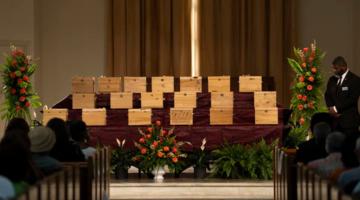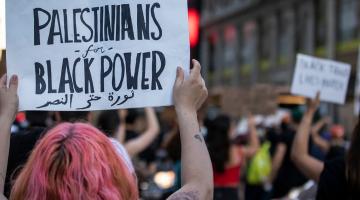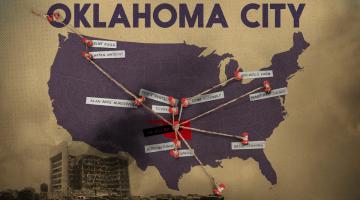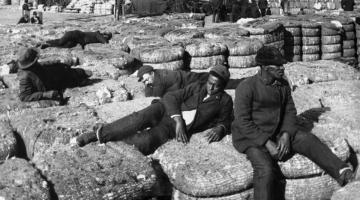“Policing precedes law and literally creates it as it goes along.”
At the service for Stephon Clark, killed by Sacramento police officers on March 18, 2018, a ribbon affixed to a memorial wreath read, “Rest in Power.” This riff on the customary “rest in peace” references multiple meanings, including “no justice, no peace,” “black power,” and the death-defiance enunciated across black expressive cultures since the dawn of the African slave trade.[i] Police shot at Clark twenty times, hitting him with seven bullets, mostly in the back, as he attempted to enter his grandmother’s house from the backyard. In other words, Clark was shot down while engaged in a basic act of self-defense: evacuating from public police presence and entering his private home. What does it mean to consider Clark’s actions in terms of self-defense? Further, what does black self-defense mean in the face of the Fourth Amendment’s stated protections against unlawful and unwarranted search and seizure by the police?
One of the main obstacles to adequately assessing the power relations that express themselves through policing is an incorrect understanding about the relationship between law and the police. Customary thinking holds that law is created; and then the police enforce the law and the courts review their execution of law. In reality, things happen in reverse: policingprecedeslaw and literally creates it as it goes along. Fourth Amendment jurisprudence verifies this point, as does the historical context for the Constitution itself.
The counter-revolutionary Fourth Amendment
The history of the Constitutional protection against “unreasonable searches and seizures” is usually told backwards. We are usually told that the Founding Generation created the Fourth Amendment to repudiate the tyranny of generalized suspicion and invasive state power used by the Crown against the colonists. This account is historically inaccurate, and the lie is the hidden reality of slavery. Historical explanations are faithful to the colonists’ words and blind to their deeds, and since accounts of the past are always geared towards prosecuting the present, this white nationalism continues to inform contemporary controversies. That is to say, today’s movement against “police brutality” and racial profiling must advance the basic backwardness of this historical narrative: racial profiling is unconstitutional, the argument goes, because it relies upon a generalized suspicion that violates the Founders’ revolutionary independence from such tyranny.
“Slavery was itself the profound and fundamental expression of search and seizure powers over black people’s bodies, over black spaces, and over black lands, by Americans and British alike.”
As historian Gerald Horne shows, the colonists famously presented their cause as revolutionary because it sought to throw off the shackles of enslavement, when in fact their resistance was counter-revolutionary in that it endeavored to keep the shackles onthe Africans, even at pains of war with their European motherland.[ii] They condemned the writs of assistance as “instruments of slavery,” in the words of John Adams, and proclaimed themselves ready to die rather than submit to British enslavement.[iii] At its base, however, slavery was itself the profound and fundamental expression of search and seizure powers over black people’s bodies, over black spaces, and over black lands, by Americans and British alike. Ben Franklin fairly represented colonist sentiment, almost two decades before the Revolution, when he asserted, “Every slave might be reckoned a domestic enemy.”[iv]
Making eye contact
Fourth Amendment principles thus arose out of a state of war against rebellious blackness. Since the search and seizure of black people is not only standard police procedure, but more to the point, it is the primary historical purpose of policing, what is the nature of this racism? This society continues to perceive blackness principally as danger and threat; acts of violence against black people are justifiable as self-defense, obligatory to ensure the stability of society, and by definition, can never be excessive. The Fourth Amendment enshrines this power; it does not provide the means of confronting and undoing it.
The circumstances of Stephon Clark’s killing were uncannily reminiscent of numerous other such moments where black people are exercising their basic right to self-defense, such as in the events leading up to Freddie Gray’s murder on April 12, 2015. The only reason given by the police for why they pursued Gray in the first place, was because he “made eye contact” with them. Gray’s death was not chiefly dependent on the intentions of the officers to kill or even on their actions once he was in their custody, but instead rests on their license to pursue, the legal ability to seize his person in the first place. This fact was largely overlooked in the Gray case—and not because people are unaware of racial profiling’s role in black premature death, but because Fourth Amendment law makes the pursuit of Gray for “making eye contact” reasonable. Likewise, for the Clark case: it’s probable that whatever Clark was doing that evening, he attempted to retreat to his home once the police tried to make contact with him. Once a black “suspect” is visually identified, probable cause to effectuate an arrest or a “justified shooting” arises easily from any number of expressions of police power that are largely impossible to disprove after the fact and outside of the moment (resisting arrest, “illegal switchblade,” assaulting an officer, failure to comply, obstructing justice, “looking for a vandalism suspect,” and so on).
“Fourth Amendment law makes the pursuit of Gray for “making eye contact” reasonable.”
The question is how does Fourth Amendment jurisprudence cover the police pursuit of Gray and Clark in the first place? That is to say, what is the counter-revolutionary legal rationale subtending these cases? In the 1980 decision in U.S. v. Mendenhall, the Court said that the right to walk away from the police is essential to the citizen’s right to be free from unreasonable seizure, and furthermore, that discontinuation of the encounter is not itself enough to either heighten reasonable suspicion or rise to the level of probable cause. On the other hand, additional Fourth Amendment case law circumscribes Mendenhall’s application to a human being such as Freddie Gray or Stephon Clark. The most important of these cases is that of Illinois v. Wardlow. Chicago police pursued William Wardlow in 1995 because he turned and ran in the opposite direction upon seeing an approaching caravan of police cruisers on their way to raid another part of his neighborhood. Unlike Gray in Baltimore and Clark in Sacramento, however, Wardlow survived police pursuit and challenged the constitutionality of his seizure, arguing that the police did not have reasonable suspicion to stop him in the first place. In Wardlow, the Court first acknowledged its own prior rulings that presence in a “high-crime area” and refusal to cooperate with police, such as in running away, cannot constitute reasonable suspicion.[v] But then the Court said that when you combine these factors—evading the police while in a “high-crime area”—the stop-and-frisk becomes constitutional. Since crime rates are a reflection of policing, not of criminal activity, essentially the Court is nullifying black self-defense on the basis of a racist geographic assignation created by the police themselves: “high-crime area” being merely a proxy for “black neighborhood.” Given that this spatial construction occurs most fundamentally at the level of the body itself, we can fairly conclude that every black person, anywhere, anytime, is “stop-eligible.”[vi] Since this practice of seizing black bodies predates the Fourth Amendment, policing precedes law and licenses the regulation of black self-determination as an unmitigated social threat.
“Essentially the Court is nullifying black self-defense on the basis of a racist geographic assignation created by the police themselves: ‘high-crime area’ being merely a proxy for ‘black neighborhood.’”
Both of these cases underscore that black people are being punished for their non-submission generally. Gray was hunted down and killed for “making eye contact” and for non-submission to the control those eyes aim to impose on all black people. Clark was hunted down and killed because his was a black body moving away from police interdiction in the night. In this light, the best precedent is not Wardlow, but rather the lynching of Emmett Till in 1955. Although the popular narrative has long held that Till, being a native of Chicago, was naïve about the South’s white supremacist etiquette and committed a capital offense by whistling at a white woman, this account underestimates both Till and the norm that he violated. It is more ethical—meaning, more accurate an account of the power relations at work—to state that Till was murdered not for something that he did, but rather for his general presentation of non-submission to whiteness.[vii] Black self-defense before the law remains illicit and strictly underground.
Next week at Black Agenda Books: Part II, “Stand Your Ground’: Siwatu-Salama Ra and Black Self-Defense.”
Tryon P. Woods teaches Crime & Justice Studies at the University of Massachusetts, Dartmouth and Black Studies at Providence College. He is the co-editor of On Marronage: Ethical Confrontations with Antiblackness (Africa World Press) and Conceptual Aphasia in Black: Displacing Racial Formation (Lexington), co-author of the forthcoming Ex Aqua: The Black Mediterranean and the Excavation of Black Power (Manchester UP), and author of the forthcoming Blackhood Against the Police Power: Punishment and Disavowal in the “Post-Racial” Era (Michigan State UP).
Notes
[i] On the latter score, see Aime J. Ellis,If We Must Die: From Bigger Thomas to Biggie Smalls(Detroit: Wayne State, 2011).
[ii] Gerald Horne, The Counter-Revolution of 1776: Slave Resistance and the Origins of the United States of America(New York: NYU, 2014).
[iii] From the legal papers of John Adams, as cited in Andrew E. Taslitz, Reconstructing the Fourth Amendment: A History of Search and Seizure, 1789-1868(New York: NYU, 2006), 39 n78.
[iv] Cited in Horne, 19.
[v] Brown v. Texas, 443 U.S. 47 (1979); Florida v. Bostick, 501 U.S. 429 (1991); Adams v. Williams, 407 U.S. 143 (1972) (presence in a “high-crime area” is an appropriate consideration in Terry analysis);United States v. Sokolow, 490 U.S. 1 (1989) (evasive behavior similarly pertinent); Florida v. Rodriguez, 469 U.S. 1 (1984) (same); United States v. Brignoni-Ponce, 422 U.S. 873 (1975) (same).
[vi] Margaret Raymond, “Down on the Corner, Out in the Street: Considering the Character of the Neighborhood in Evaluating Reasonable Suspicion,” Ohio State Law Journal, 60 (1999), 99.
[vii] Carolyn Bryant admitted in a 2007 interview with historian Timothy Tyson that she fabricated the story about Till making advances on her. See Timothy B. Tyson, The Blood of Emmet Till(New York: Simon & Schuster, 2017).


















